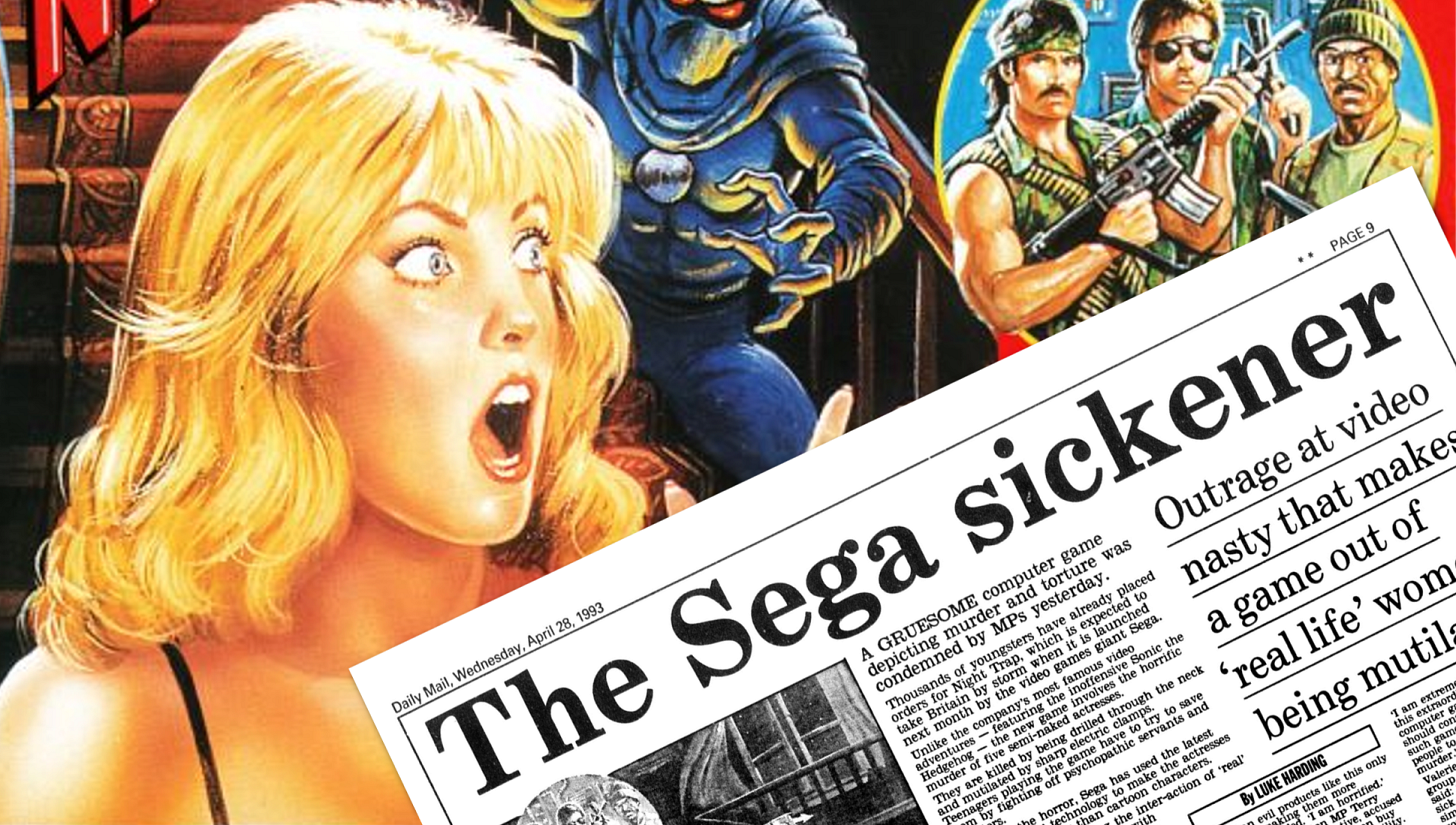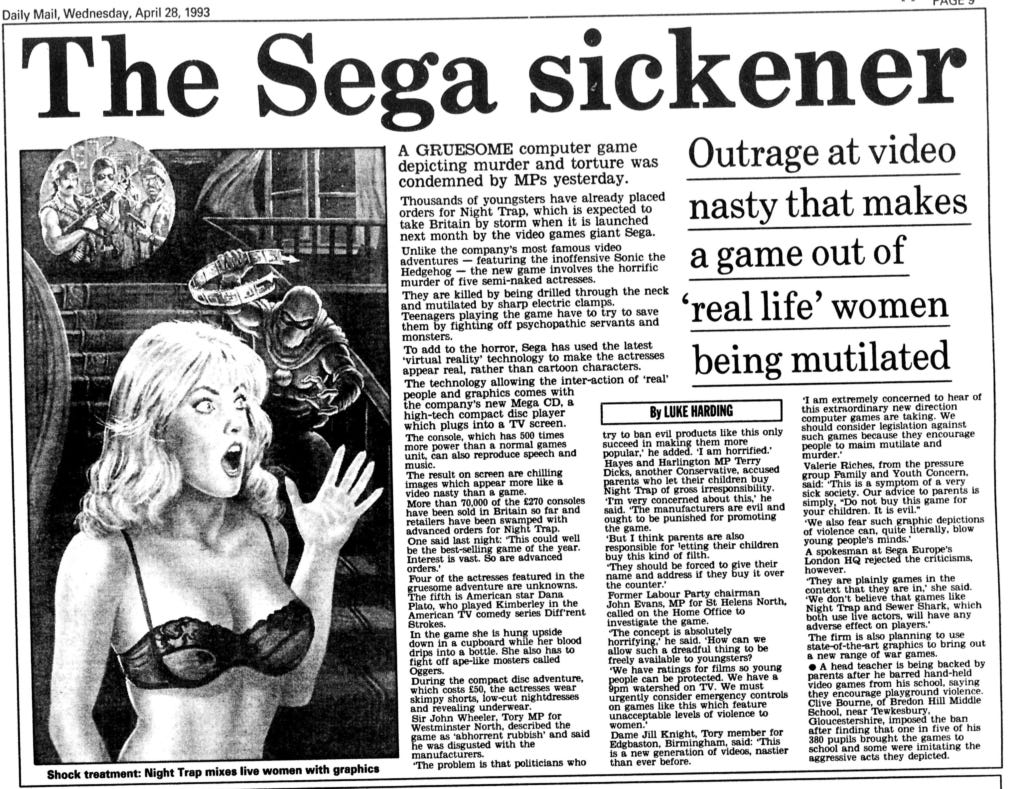The Infamous Sega Sickener Article
The 'Sega Sickener' was an infamous article printed by the Daily Mail concerning the release of the videogame Night Trap on the Sega Mega CD
Video games, video games, video games. We love them, but they’ve gotten a bad rap over the years. The mainstream press has not always been particularly kind to video games, and sometimes they’ve been downright vitriolic. This is going to be the first article in a series in which I take a look at moments in which gaming has popped up in mainstream news and culture, we’ll be exploring how the games were presented, adding some context around the stories, and maybe having a bit of a laugh. We’re going start off this little series with an infamous article from 28th April 1993.
The Daily Mail has never been a particularly well respected news outlet. It’s not a paper that’s made to tell stories, but to sell as much as possible by printing as shocking headlines as possible. It gets people riled up, annoyed, and they buy into the ethos and culture of the paper.
The article we’ll be looking at today, is known as the Sega Sickener. To give some context around this article, I need to give a little backstory on one game in particular, Night Trap.
The Mega CD was Sega’s attempt to answer the threat that the Super Nintendo was posing to it’s market share, by releasing a console that could do something the SNES could not. It would utilise CD’s as it’s medium, and be marketed as a more powerful system because of it. Intended to be marketed towards American audiences and released in October 1992 in the United States, Night Trap was a game featuring heavy use of full motion video, a novelty at the time which was made possible by the large storage capacity that CD’s had to offer.
The objective of the game, was to save a bunch of high school girls having a slumber party from masked ninja’s intent of a bit of murder. The game would have you watching security cameras, and triggering traps to catch the baddies at specific moments. Even though the game was released in the 90’s, it was originally supposed to be part of a VHS based system that was being developed by Hasbro in the 1980’s, so principal photography was actually shot in 1987, which is why the footage looks a little out of place. There wasn’t a huge amount more to the game really, and this article was written around a month before it’s UK release.
The article begins with the big bold headline ‘The Sega Sickener’ spread right across the page. The quote that has been taken from the article for people scanning through, says ‘Outrage at video nasty that makes a game out of ‘real life’ women being mutilated’. Gasp you might think, that sounds terrible. A video nasty was a colloquial term in the early 80’s for movies which came out on video that would usually not be legible for a cinema release, due to heavy violence, obscenity and nudity. This was possible because originally videos did not need to recieve a classification to be released. So by comparing the game to a video nasty, they are immediately giving the impression of something that is extreme and over the top, and should potentially be banned.
It’s worth remembering that this article was written before Night Trap actually came out in the UK, so there was a good chance that the writer of the article never played the game, only that he had heard the stories from it’s release in the USA. The article describes the game as being expected to take Britain by Storm when it launches, despite the fact that later on in the article they say that only 70, 000 Mega CD consoles had actually been sold in Britain by that point, hardly enough for a storm. This number may also be false, as some sources claim that was the total number of Mega CD’s that had been shipped to retailers at the time, rather than the amount actually sold.
It goes on by describing some of the events which can happen to the characters in the game, such as being drilled through the neck and mutilated by sharp electric clamps. It makes a small mention that the aim of the game is actually to save the girls that are in trouble, but it doesn’t elaborate, and the rest of the article makes it seem as if the objective is to do the murdering.
It’s quite funny looking back at these sort of pieces nowadays, especially in how they describe full motion video on a games console. They say that Sega has used the latest ‘virtual reality’ technology to make the actresses appear real, allowing the inter-action of ‘real people and graphics’ and inexplicably they claim the console has ‘500 times more power than a normal games unit’. At this point, it almost seems like a good advert for the Mega CD.
Later on, they claim an unamed source said that Night Trap could even be the ‘best selling game of the year’. Night Trap would go on to be one of the best selling games on the Mega CD, but it was never close to being a best selling game overall. The article describes a bit more about the game, before revealing something even worse than the murder. The actresses wear skimpy shorts, low cut nightdresses and revealing underwear. I think this was pretty evident from the picture they decided to use to illustrate the game.
This is the point at which the Daily Mail decides to get some opinions from some gob for rents, politicians who just like to comment on every story they can in order to get their name out there, regardless of whether they know what they are talking about or not. Sir John Wheeler, Tory MP said the game was ‘abhorrent rubbish’ and that he was ‘horrified’. Another Tory MP, Terry Dicks, who has many opinions on videogames as we’ll see later in this series, said that the manufacturers were ‘evil and ought to be punished for pomoting this game’ and that any parents who let their children buy the game should ‘be forced to give their name and address if they buy it over the counter’. He doesn’t say what he’ll do with the address, likely write them a strongly worded letter I’d imagine.
Then we have Labour party MP John Evans who said that the ‘concept is absolutely horrifying’. Strange that he believes the concept of saving women from murder is horrifying, He goes on to say that ‘we have ratings for films so young people can be protected. We have a 9pm watershed on TV. We must urgently consider emergency controls on games like this’. He was foretelling the future a little bit there, as Night Trap was one of the games that caused big shocks in the realm of video games rating. This was much more true in the United States though than it was in the UK, as our rating system got quite convoluted in the 90’s, which I’ll cover in a future episode.
Next up, we have Dame Jill Knight, who said that these computer games ‘encourage people to maim, mutilate and murder’ another person that clearly didn’t know what the game was about. Valerie Riches, from a terribly fun sounding group called Family and Youth concern, said that this game is a ‘symptom of a sick society’ and that amazingly, she thinks that ‘such graphic depictions of violence can, quite literally, blow young people’s minds’. I’m not sure she understood the context of the phrase blowing someones mind or she wouldn’t have used it, because it just makes the game sound cooler.
Sega did get a chance to reply to these criticisms, stating that ‘They are plainly games in the context that they are in’ and ‘we don’t believe that games like Night Trap and Swer Shark, which both use live actors, will have any adverse effect on players’. They clearly couldn’t be bothered to go much more into it than that, as what else can you say to these kinds of comments? The context of video gaming at the time, was that video game developers and publishers wanted to start making games which were marketed to and designed to appeal to adults, capitalising on the fact that consoles like the Mega CD were more expensive than a regular games console, so would likely have less traction amongst child audiences. However, the non gaming public and particularly the press didn’t seem to understand this, in their minds every video game was designed for children, so they should always be family friendly, all of the time, and when they wasn’t, they were outraged. Or at least, they pretended to be outraged.
This article and others like it created a sense of infamy around Night Trap, when it was in actuality a fairly run of the mill full motion game. If it wasn’t for this kind of press, the game would have likely faded into obscurity, but it developed this mysterious quality around it, which helped it succeed. This article in particular though had one specific effect. Nick Alexander, who ran Sega Europe at the time, described a moment in which a PR agency came into a meeting with him, threw the article down on the table, and claimed ‘this is disgusting, how can we possibly work with you when you do this kind of thing?’. He asked them if they had actually seen the game, to which they said they hadn’t, so he sat them down and let them play it. After they had been shown the game, they realised that the article was completely misleading, and realised their mistake.
So this was our look at the infamous Sega Sickener article. It was a combination of misunderstanding of what the game was about, misunderstanding of what the Mega CD was capable of, as well as forced outrage by people wanting to make a name for themselves.





